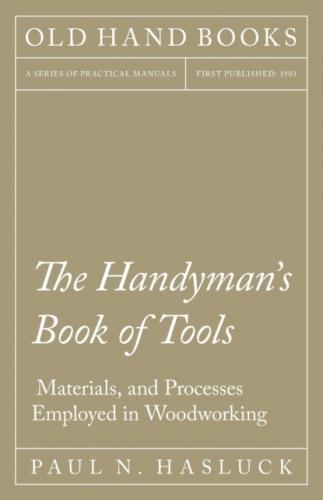Fig. 14.—Mitre Square.
Fig. 15.—Iron Frame Try Square.
CRENELATED SQUARES.
A crenelated square has a tongue in which there is a series of crenelations or notches at the graduations. It is especially useful in marking off mortises, etc., though it is available for all other ordinary applications. Three sides of a piece of timber can be set out without moving the work. To use this square, say in marking out a mortise or tenon, take it in the left hand and lay its tongue upon the surface of the work, as in Fig. 20. The lower end of the main arm is lowered for 2 in. or so from the surface to get a better purchase, and then an awl, held in the right hand, is placed in a notch at the correct distance from the edge to mark the left-hand edge of the mortise or left-hand face of tenon as the case may be. Then push the square forward, pressing it down gently upon the work, and one mark will have been made. Replace the square, and with the awl in another notch at the thickness of the tenon or width of the mortise make a second mark. Horizontals are drawn by means of the smooth edge of the tongue (see Fig. 20).
Fig. 16.—Adjustable Try Square.
Fig. 17.—Ordinary Sliding Bevel.
Fig. 18.—Brass Frame Sliding Bevel.
MARKING WORK FOR SAWING.
The chalk line, pencil and rule, and scribe are variously used for the marking of the lines by which the saw is guided. The first-named is used for long pieces of timber, the second for ordinary and roughly approximate work, the third for the most accurate sawing. Lining off a plank or board for ripping, when rough on the edges, is commonly done with a straight-edge or chalk line. If square-edged it can be done by the rule and pencil, as explained in Fig. 21. The rule is held in the left hand, measuring off on the board the breadth to be ripped, and the forefinger placed against the edge to act as fence. The pencil is held in the right hand to the end of the rule on the board. Both hands are then moved simultaneously, and the required line is traced backward or forward, as may be desired. Lines for cross-cutting, when square across or at right angles to the edge, are readily obtained by the square, keeping its blade flat on the board or plank and its stock hard to the edge (see Fig. 22). For lines at a right angle to the edge use the mitre square (see Fig. 23), and for other angles, set and apply the bevel-stock in the same way (see Fig. 24). For this and similar purposes the bevel-stock differs from the square only in having the blade movable, and capable of being adjusted at any desired angle: with the stock by means of a screw. In the chalk line method of marking (see Fig. 25) a piece of fine cord is whitened with chalk, and being strained taut between two points whose positions are marked to correspond with the terminations of the line of cut, the chalk line is lifted vertically at or near the centre, and, being suddenly released, chalks a perfectly straight and fine line upon the timber, and furnishes a correct guide to the saw. Lines are marked with the timber scribe in such cases as squaring the ends of planed stuff and in marking dovetails and tenons. The saw may then be made to cut close outside the scribed line, allowing just sufficient margin of material to be removed with the plane; or the saw may pass right along the scribed line, as in cutting dovetails and tenons, no after-finish being required. In either case the scribed line is preferable to the pencil-marked one, because the cutting can be done much more accurately in the first case than in the latter. Also, when the end of a piece of timber has to be squared with the plane, there is, besides the greater accuracy, much less risk of spalting or breaking out of the grain occurring with scribed lines than with pencil-marked lines. In the case of planed ends, a careful workman will also contrive to saw extremely close to the scribed lines, in order to diminish as much as possible the labour of planing.
Fig. 19.—Testing Try Squares in Truth.
Fig. 20.—Marking Mortise with Crenelated Square.
Fig. 21.—Lining Board with Rule and Pencil.
Fig. 22.—Squaring Line on Board.
Fig. 23.—Marking Mitre Line on Board.
Fig. 24.—Using Sliding Bevel.
Fig. 25.—Using Chalk Line.
Fig. 26.—Pencil Gauge with Round Stem.
MARKING AND CUTTING GAUGES.
The carpenter draws a line at a short distance from, and parallel to, the edge of a board by means of a rule and pencil, the method being made clear by Fig. 21, p. 9. The use of the pencil or marking gauge would be found an advantage over this method. It will be seen from Figs. 26 and 27 that there are two ways of making the pencil gauge. It can be made of any hard wood, preferably beech. The stem may be round (Fig. 26) or square (Fig. 27) in section, and the head may be round or octagonal. The head must slide up and down the stem easily, but without sideplay. The gauge may be made to use up odd pieces of lead pencil, and these should be sharpened (with a chisel) to a wedge-shaped point. Figs. 28 and 29 show a pencil gauge made from a broken rule fitted into a block so as to run easily, and secured at any distance (as indicated by the rule’s edge) by means of a thumbscrew. A is a block of birch, 1 1/2 in. by 1 in. by 1 in., mortised so as to receive
